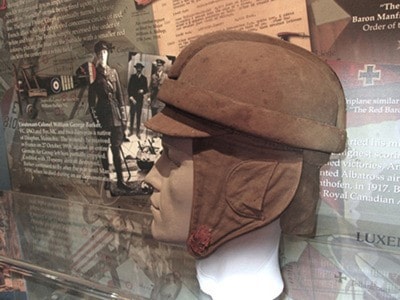Mel Birnie
Special to The Record
The Comox Air Force Museum has a dedicated group of individuals who sit on our Collections Management Committee.
When an artifact is donated, it is evaluated on its relevance to the museum, its condition, and its rarity. Most people would assume that if an item is rare that it would be automatically accepted into our collection, but an artifact’s relevance to the museum’s mandate is the true determining factor.
The story began when Don Magor of Campbell River inquired if our museum would be interested in the donation of a WW1 German pilot’s helmet. The helmet was a battlefield souvenir from his grandfather, the former Chief of the Air Staff R.C.A.F. Overseas1944-45, Lloyd S. Breadner.
In this case the artifact was part of the story of the birth of the Royal Canadian Air Force and coincided with the 100th anniversary of the start of the First World War. Therefore, this artifact was extremely relevant to our museum.
Don Manley, one of the volunteers on the committee, noted that there was an inscription in the helmet that was barely legible. “Hun brought down near (Mnt...?) April 23’17”.
The fact that the owner of the helmet was an important personage in the RCAF and having this inscription was more information than the museum usually receives with a donation, but we wanted to see if we could find more of the story.
Our research showed that L.S. Breadner was a pilot serving with Royal Naval Air Service (RNAS) No. 3 Squadron at Marieux (Montplaisir), France and we were able to find first person accounts of his actions in aerial combat 17 April, 1917. (These are related in Jon Guttman’s Naval Aces World War 1 and, Canadian Airmen and the First World War by S.F. Wise.)
In his own account of the battle, he heard the anti-aircraft guns, looked up and saw a Hun (a Gotha Bomber 610/16 from Kampstaffel 15 KG 111) at 10,000 feet. He scrambled to 12,000 feet, intercepted the bomber and shot out its engines, forcing it to crash-land near Vron on the allied side of the lines. Lloyd then landed his plane close by and cut the Iron Cross symbol from the wing of the burning aircraft. By the end of the day that Iron Cross was hanging on a wall in No.3 Squadron’s Mess. This was the first Gotha Bomber to be shot down by a fighter plane over the Western Front.
The crew of the Gotha were taken prisoner and Lloyd kept the helmet of the pilot, Offz. Stv. Alfred Heidner, as a souvenir. The other two crew members taken prisoner that day were Lt. Karl Josef Scheuren, Observer and Lt. Otto Wirth.
F/L L.S. Breadner received the Distinguished Service Cross and attained the rank of Major during the First World War. He continued to serve in the Canadian Air Force until he was promoted to Air Chief Marshall on his retirement, 25 November 1945.
The helmet may be seen in our updated WWI exhibit.
In “Sifting through the Archives” we explore the personal history of some of the interesting people, events, and artefacts in our collection. Meet the volunteers who take the time to preserve our Canadian Military aviation history. The Comox Air Force Museum is open Tuesday to Sunday from 10 a.m. to 4 p.m. Entrance is by donation.
